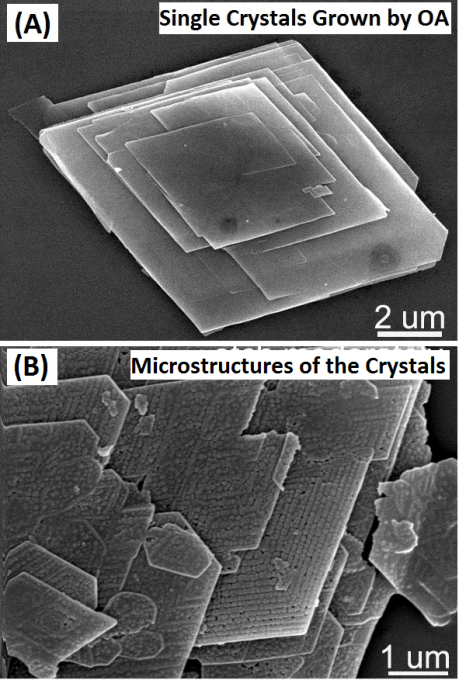May 30 2019
Researchers from China have shown that a new substance is formed during the oriented attachment (OA) process of crystal growth, which may offer new insights into the microscopic mechanism of crystal growth.
 Experimental Samples: (A) Single crystals grown by OA; (B) Microstructures of the crystals, which show the oriented alignment of the nanoparticles. (Image credit: Yang Yong)
Experimental Samples: (A) Single crystals grown by OA; (B) Microstructures of the crystals, which show the oriented alignment of the nanoparticles. (Image credit: Yang Yong)
The study was performed by the researchers at the Institute of Solid State Physics (ISSP) of the Hefei Institutes of Physical Science, Chinese Academy of Sciences and other collaborative institutions and was reported in Matter on May 29th, 2019.
Crystallization is a very common physical process that occurs naturally and artificially. The end products—crystals—play a significant role in modern science and technology. For example, single-silicon crystals have a central role to play in the semiconductor industry. Nonlinear optical crystals—such as β-BaB2O4 (BBO)—are inevitable in modern laser technology and experiments on quantum optics. High-quality single-crystalline samples are usually a prerequisite for experimental measurements and studies on novel quantum effects. Therefore, the study on crystal growth has attracted great interest.
Oriented attachment (OA) is a concept that cannot be avoided when considering crystal growth. Usually, OA is regarded as a physical process in which nanocrystals align in particular directions to form huge single crystals through interface fusion. The crystals resulting from this process possess constituent and phase structures similar to those of the precursor nanoparticles.
However, is it feasible for a novel substance to form through OA process?
To find a solution to this question, Chinese researchers carried out a series of experiments and obtained a positive answer.
With the addition of NaHCO3 into Y2(CO3)3·2H2O nanoparticle suspensions in an aqueous solution, the scientists obtained single crystalline sheets labeled as NaY(CO3)2·6H2O. A similar product ((NH4)Y(CO3)2·H2O) was obtained by the addition of (NH4)HCO3 into the suspension.
With the modern experimental methods, the characterization of morphology and atomic structures of the products was performed. Together with theoretical calculations, the scientists provided convincing evidence that the mechanism behind the synthesis process is a new kind of OA and termed it as “Chemical Reaction-directed Oriented Attachment” (CROA).
We believe that the discovery of CROA will pave a new way for the synthesis of novel functional materials, and deepen the understanding of the mechanism of natural mineral formation.
Qin Xiaoying, Corresponding Author, ISSP
The study was financially supported by the National Natural Science Foundation of China.